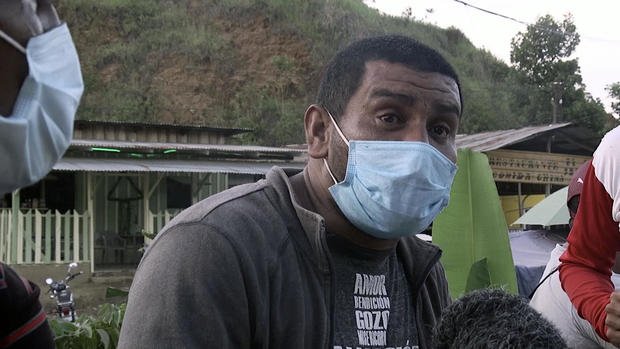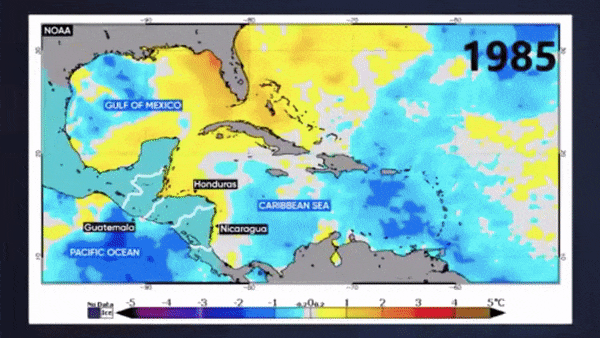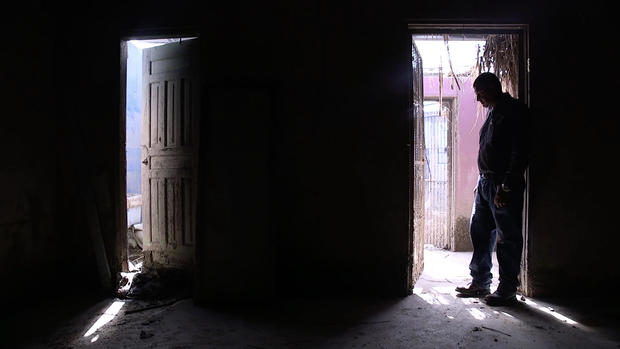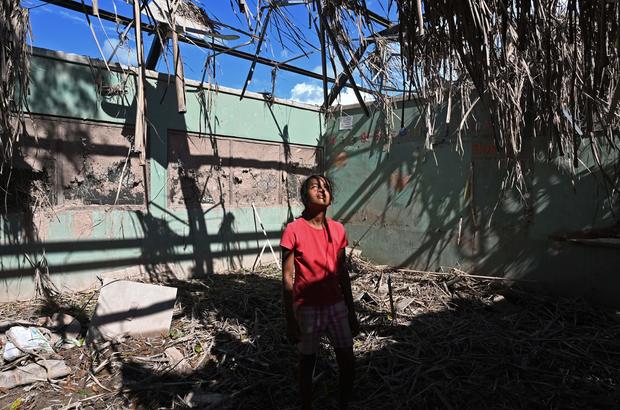"We have to go": Climate change driving increased migration from Central America
As the Earth continues to warm, climate disasters are getting more extreme. In 2020, the impact was on vivid display with record-shattering wildfires in the western U.S. and the historic Atlantic hurricane season.
Destroying homes and livelihoods, these types of events often act as triggers, leaving people with little choice but to move, especially if they were already socially or economically vulnerable. This phenomenon is called climate migration and it is becoming more common because of human-caused climate change.
This past autumn we witnessed the beginning of what may be one of the most straightforward examples of climate-induced migration in Central America. Around 10,000 people have already attempted to migrate northward after two devastating storms hit, and many more are planning to leave soon.
In November, Hurricane Eta and Hurricane Iota, both catastrophic Category 4 hurricanes, made landfall two weeks and only 15 miles apart, near Puerto Cabezas, Nicaragua. They were two of the most intense storms of the most active Atlantic hurricane season in recorded history.
With winds of 150 mph and devastating flooding from torrential rains, the storms impacted 6 million people, destroyed thousands of homes and displaced nearly 600,000 in Honduras, Guatemala and Nicaragua. With little to no government assistance, many of those displaced are living in shelters with little food. As of early January, the Red Cross reported 250,000 were still in emergency shelters throughout the region.
It's not only housing and food that are in short supply; many people have also lost their livelihoods. The Ministry of Agriculture and Livestock in Honduras estimates that up to 80% of the agricultural sector was decimated by the storms — an industry that, as of 2020, provided one-third of the country's employment.
With few options at home, in mid-January up to 9,000 people gathered to join a caravan in Honduras heading to Mexico and the United States in search of opportunity. A CBS News crew caught up with a few of the migrants in Honduras. We asked why they made the risky choice to leave their country and families behind.
Marlin Oviedo, a father of three, told us: "There is no employment, there is nothing. Because we work in agriculture and you saw the two hurricanes that damaged all the crops, we have nothing. We have to go out and find what we can offer our children, because we have nothing."
Holding back tears, Oviedo said he felt he had no choice. "I am leaving three girls behind — a 4-year old girl, a 12-year-old with special needs, and a 16-year-old. And it hurts me to leave, but I believe I have to."
It is unclear if Oviedo made it. As the caravan crossed into Guatemala, the group clashed with the Guatemalan military, which broke up the caravan and sent many of the would-be migrants back to Honduras.
"If people feel their lives are in jeopardy, there's nothing that will deter them from fleeing to safety," explained Michael Chertoff, the former Secretary of Homeland Security under President George W. Bush, in an October interview with CBS News. He said massive dislocation caused by people's inability to live in certain areas, due to climate change and socioeconomic factors, is one of his biggest international security concerns.
In 2019, the Internal Displacement Monitoring Centre (IDMC) calculated that weather-related disasters, some of them tied to climate change, displaced almost 24 million people around the globe — about three times more than those displaced by conflict that year. These disasters included unprecedented back-to-back cyclones in Mozambique, Hurricane Dorian in the Bahamas, and the wildfires in California.
The record-breaking 2020 Atlantic hurricane season is just another example of how climate change is making weather events more extreme, driving people to migrate from their homes. While hurricanes in the western Caribbean are common during the fall, Eta and Iota were remarkably strong for so late in the season. The intensity of these storms was fueled by some of the warmest water in the Northern Hemisphere, enhanced by human-caused climate change.
As the image below shows, since the 1980s water temperatures in the Caribbean have been steadily increasing. The Atlantic overall has warmed more than 2 degrees Fahrenheit since the early 1900s.
In the below tweet from British climate scientist Richard Dixon, the map shows (in yellow) how water temperatures in the Caribbean are surpassing 83 degrees Fahrenheit more often. This warmer water provides high-octane fuel to supercharge storms, taking run-of-the-mill hurricanes and making them into monsters like Eta and Iota.
This matters because while much of the infrastructure in Central America may be able to withstand the force of typical hurricanes, major hurricanes are often too much to bear.
In Honduras alone, more than 85,000 homes were damaged in the two storms. NOAA estimates that 85% of all damage from hurricanes comes from the strongest storms — major Category 3, 4 or 5 systems.
Kayly Ober, senior advocate and program manager of the Climate Displacement Program at Refugees International, says the 2019 disasters, as well as hurricanes Eta and Iota, are examples of "sudden-onset" events. She fears these types of events, and the migrations that follow, are a sign of things to come.
"Sudden-onset events such as these will only increase in intensity and frequency in the future," she said.
But she explains that migration caused by these climate events doesn't happen in isolation — it's often tied to a community's existing vulnerability and inability to adapt. "Climate change impacts and socioeconomic issues are heavily intertwined."
Angel Munoz, a climate scientist at the International Research Institute for Climate and Society at Columbia University, agrees. He noted that many people in these communities were dealing with chronic poverty, crime and other difficulties before disaster struck.
"These people were already struggling, even without any hurricane or drought. They are already struggling to survive," Munoz said. Sudden-onset events are often the straw that breaks the camel's back, and like Ober, Munoz expects climate-triggered migration events will escalate in a warmer future.
But it's not only sudden climate events like Eta and Iota that are causing hardship and driving migration from Central America.
"Slow-onset events, such as prolonged drought, have been affecting the ability of many people on the edge for years in the region, particularly in the so-called Dry Corridor, which runs from Southern Mexico to Costa Rica," explained Ober.
The U.N. Food and Agricultural Organization estimates that 3.5 million people in the region have faced food insecurity in the past 10 years due to recurring droughts, driven by natural climate variability and climate change. The Climate Reality Project does a good job of explaining how these climate shifts helped lead to high rates of migration in 2018.
Whether it be slow-onset events like drought, or sudden-onset events like hurricanes, what we are witnessing is just the tip of the iceberg as a hotter Earth means more extreme weather. We are already seeing evidence of the impacts. A recent report by Refugees International says, "The trends are clear—sudden-onset disasters are becoming more frequent and intense; disasters are leading to protracted displacement." And the World Bank predicts that unchecked carbon emissions could lead to 143 million internal climate migrants by 2050 in Latin America, the Caribbean, South Asia and Sub-Saharan Africa.
With the threat of increased climate migration in mind, President Biden recently signed an executive order on "Rebuilding and Enhancing Programs to Resettle Refugees and Planning for the Impact of Climate Change on Migration," which orders federal agencies to prepare and submit a report on climate change and its impact on migration. Mr. Biden directed that the report must include discussion of the international security implications of climate-related migration and options for protection and resettlement of individuals displaced directly or indirectly from climate change.
This is an important step for those forced to flee their countries due to climate change. That's because the U.N.'s 1951 Refugee Convention does not cover climate-related migration. It defines refugees as those who are outside their country of origin and have a well-founded fear of persecution based on race, religion, nationality, political opinion, or membership in a social group. Because this definition does not address migration resulting from climate change, those people have not been able to obtain international protection.
The Refugees International report praises the initial steps of the Biden administration and argues that "the United States has a moral and practical responsibility to lead on issues of climate change, migration, and displacement" because the U.S. has been responsible for the largest share of heat-trapping fossil fuel emissions over time.
"We need to realize that climate change impacts are already influencing decisions to migrate today, and ensure that people moving are able to access safe and dignified pathways in their own country and abroad," said Ober.
It will take financial commitment to help reduce the risk of disaster, adapt to the impacts of climate change and build resilience. Ober believes the United States and its allies should step up financing for existing international aid funds, such as the Green Climate Fund, which was created by the U.N. to help developing countries reduce emissions and enhance their resilience to climate change.
In fact, in its report, the World Bank predicts that robust action on cutting carbon emissions and supporting a green transition could reduce the total number of climate migrants by 50% to 80% — that's 31 to 72 million people — by 2050.
But without a comprehensive plan to reel in carbon emissions and effective policies to deal with the growing threat of climate migration, Ober fears many more people will be forced to flee.
"I am concerned that climate change impacts will only increase in frequency and intensity, and that without proper support or policy intervention, people will have to make the difficult to decision to move."
for more features.




